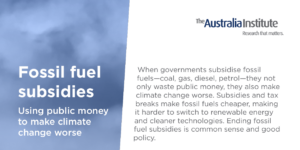Ignore the fears from the gas industry, Australia has more than enough gas
Once again the gas industry is crying wolf and telling us we need more gas to prevent shortages. But if you read beyond the scare quotes today’s report from Australia’s Energy Market Operator report shows we already have more than enough gas.
The latest Gas Statement of Opportunities released by AEMO seems to suggest – like the previous year’s report – that Australia may be facing gas shortages. And the best way to address this is, of course, to produce more gas.
Given that the report relies on information from gas industry participants, it is not surprising that continues the pattern of previous years of fearmongering about shortages and recommending ongoing investment in gas infrastructure in order to meet demand. And yet within the report itself, the data reveals just how wrong this argument is.
Australia is projected to use much less gas for electricity generation than it currently does.
Under the AEMO forecast scenario of step changes under a 1.8C scenario Australia from 2024 onwards is projected to use less gas for electricity generation than it ever has in the past. Surely this should be the heading of AEMO’s report?
Unfortunately, the promotion of gas has become a bipartisan position in Australian politics. From the former government’s calls for a “gas-led” recovery to the current Prime Minister Anthony Albanese suggesting that “gas, in particular, has a key role to play, as a flexible source of energy… Helping to smooth the transition to renewables.”
The idea that gas is a transition fuel and can lower emissions has been thoroughly debunked. Any transition does not need new infrastructure and investment that the industry suggests in the AEMO report. We already have more than enough gas. The problem is not a lack of supply, it is that Australia’s gas is overwhelmingly exported.
The AEMO report suggests that by 2030 the amount of gas needed for electricity generation in Australia will have dropped by a third. Yet AEMO forecasts that in the same year gas companies will still be exporting the same amount they are now.
The irony is that most gas demand in Australia comes from the gas industry itself to produce LNG! Most Australians can, and will, do just fine with less gas. The answer to tackling short and medium-term supply issues and reducing emissions is to transition to renewables faster than we currently are.
[An earlier version of this graph incorrectly displayed 2022 figures and this graph has been updated with 2023 figures]
Related research
Between the Lines Newsletter
The biggest stories and the best analysis from the team at the Australia Institute, delivered to your inbox every fortnight.
You might also like
We need political courage, not caution | Polly Hemming
When it comes to solving the biggest national problems, a bit of courage leaves political caution for dead. Now’s not the time for politeness.
The great gas rip off: how the government can stop us all getting burned
The Albanese government could soon intervene to start fixing one of the biggest ongoing public policy fiascos in this country’s history: Australia’s rampant, uncontrolled gas export industry.
Fossil fuel subsidies
When governments subsidise fossil fuels—coal, gas, diesel, petrol—they not only waste public money, they also make climate change worse. Subsidies and tax breaks make fossil fuels cheaper, making it harder to switch to renewable energy and cleaner technologies. Ending fossil fuel subsidies is common sense and good policy.



